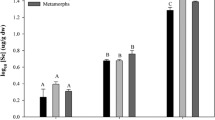Abstract
High concentrations of selenium threaten waterfowl at California San Joaquin Valley agricultural wastewater evaporation ponds. This study evaluates and compares two routes of Se exposure and uptake by third instar Ephydra cinerea (brine fly) larvae. A 48-h static bioconcentration bioassay provided information on the larval uptake of selenate, selenite, and seleno-DL-methionine (SeMet) at Se waterborne concentrations ranging from 10.0–20,000 ug/L. At equivalent concentration levels, SeMet was bioconcentrated to a greater extent than selenite, which was bioconcentrated more than selenate. Forty-eight-hour static bioconcentration vs. biomagnification bioassays allowed for comparisons of the two routes of exposure of selenate, selenite, and SeMet. Biomagnification was determined to be the primary Se uptake pathway, exemplified most notably in the selenite treatment. Measured agar-based food unit Se levels presented evidence that the uptake of selenite, and especially SeMet, by microbial populations was transferred to E. cinerea larvae as they scavenged for bacteria and yeast, etc. in the diet matrix. As a primary dietary item of waterfowl at evaporation ponds, E. cinerea in seleniferous waters presents a potentially high hazard.
Similar content being viewed by others
References
Besser JM, Huckins JN, Little EE, La Point TW (1989) Distribution and bioaccumulation of selenium in aquatic microcosms. Environ Pollut 62:1–12
Burau RG (1985) Environmental chemistry of selenium. Calif Agric 39:16–18
CRWQCB CVR (California Regional Water Quality Control Board, Central Valley Region) (1990) Water quality in evaporation basins used for the disposal of agricultural subsurface drainage water in the San Joaquin Valley, California 1988, 1989
Demayo A, Taylor MC, Reeder SW (1979) Guidelines for surface water quality, Vol. 1: Inorganic chemical substances: Selenium. Environment Canada, Inland Waters Directorate, Water Quality Branch, Ottawa, Canada
Doran JW (1982) Microorganisims and the biological cycling of selenium. Adv Microbiol Ecol 6:1–32
Doran JW, Alexander JM (1976) Microbial formation of volatile selenium compounds in soil. Soil Sci Soc Am J 40:687–690
Fraenkel G, Bhaskaran G (1973) Pupariation and pupation in cyclorrhaphous flies (diptera): Terminology and interpretation. Annals Entomol Society Amer 66 (2):418–422
Frost DV, Lish PM (1975) Selenium in Biology. Ann Rev Pharmacol 15:259–284
Knight AW (1990) Determination of critical components in selenium uptake and biotransformation by evaporation pond organisms. Annual Report—Year One: Prepared for Westlake Farms, Inc., Davis, CA
Letey J, Roberts C, Penberth M, Vasek C (1986) An agricultural dilemma: Drainage water and toxics disposal in the San Joaquin Valley. Oakland, CA: The Regents of the University of California, Berkeley, CA
Maier KJ, Foe C, Ogle RS, Williams MJ, Knight AW, Kiffney P, Melton LA (1987) The dynamics of selenium in aquatic ecosystems. In: Hemphill, DD (ed) Trace substances in environmental health-XXI. Proceedings of the University of Missouri's 21st Annual Conference on Trace Substances in Environ Health, University of Missouri, Columbia, MD, pp 361–408
Moore SB, Winckel J, Detwiler SJ, Klasing SA, Gaul PA, Kanim NR, Kesser BE, DeBevec AB, Beardsley K, Puckett LK (1990) Fish and wildlife resources and agricultural drainage in the San Joaquin Valley, California. Prepared by the San Joaquin Valley Drainage Program, Sacramento, CA
Nelson D, Suekawa DM, Havertz DS (1974) Trophic relationship of brine fly and algae of the Great Salt Lake, Utah. Ut Acad Proc 51(1):51–55
Ogle RS, Maier KJ, Kiffney P, Williams MJ, Brasher A, Melton LA, Knight AW (1988) Bioaccumulation of selenium in aquatic ecosystems. Lake Reserv Manag 4(2):165–173
Ohlendorf HM, Hoffman DJ, Saiki MK, Aldrich TW (1986) Embryonic mortality and abnormalities of aquatic birds: Apparent impacts of selenium from irrigation drainwater. Sci Tot Environ 52:49–63
Parker M, Knight AW (1989) Biological characterization of agricultural drainage evaporation ponds. Dept. of Land, Air, and Water Resources, Univ. of Cal., Davis, Water Science and Engineering Paper No. 4521, Prepared for Central Valley Regional Water Quality Control Board, Sacramento, CA
Richards OW, Davies RG (1977) Imms' general textbook of entomology, tenth edition, volume I: Structure, physiology, and development. Chapman and Hall, N.Y.
Robberecht H, Van Grieken R (1982) Selenium in environmental waters: Determination, speciation, and concentration levels. Talanta 29:823–843
Saiki MK, Lowe TP (1987) Selenium in aquatic organisms from subsurface agricultural drainage water, San Joaquin Valley, California. Arch Environ Contam Toxicol 16:657–670
Scheiring JF (1974) Diversity of Shore flies (Diptera: Ephydridae) in inland freshwater habitats. J Kansas Entomol Soc 47(4):152–166
Skorupa JP, Ohlendorf HM (1991) Contaminants in drainage water and avian risk thresholds. In: Dinar A, Zelberman D (eds) The Economics and Management of Water and Drainage in Agriculture. Kluwer Academic Publishers, Boston, MA, pp 345–368
Stadtman TC (1979) Some selenium-dependent biochemical processes. Adv Enzymol Relat Areas Mol Biol 48:1–28
Turner MA, Swick A (1983) The English-Wabigoon River system: IV. Interaction between mercury and selenium accumulated from waterborne and dietary sources by northern pike (Esox lucius). Can J Fish Aquatic Sci 40:2241–2250
Welker MC, Havertz DS (1973) A study of species diversity of the genus Ephydra on the Great Salt Lake. Utah Acad Proceedings 50(2):78–80
Windholtz M (ed) (1976) The Merck Index, 9th Edition. Merck and Co. Inc., Rahway, NJ
Author information
Authors and Affiliations
Rights and permissions
About this article
Cite this article
Rosetta, T.N., Knight, A.W. Bioaccumulation of selenate, selenite, and seleno-DL-methionine by the brine fly larvae Ephydra cinerea Jones. Arch. Environ. Contam. Toxicol. 29, 351–357 (1995). https://doi.org/10.1007/BF00212500
Received:
Revised:
Issue Date:
DOI: https://doi.org/10.1007/BF00212500




